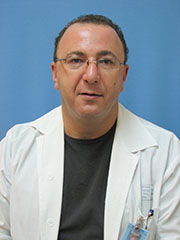|

Assistant Professor Boris Kessel |
All they had intended to do at the Trauma Unit of the Hillel Yaffe Medical Center was to check whether it was necessary to make any changes in the methods of treatment, monitoring and follow-up of pregnant women who had been injured in road accidents. The results they received surprised those who had led the study, Assistant Professor Boris Kessel, Director of the Trauma Unit, and Dr. Netanela Miller, who had undertaken the study with him, when it turned out that something in pregnancy was able to significantly reduce the degree of injuries and even to avert death.
The study performed at “Hillel Yaffe” was a retrospective research based on registration data of the National Trauma Institute (“Gertner” Institute). The data reviewed included specification of the degrees of severity of injuries of 3,794 pregnant women, and 3,441 women who were not pregnant, who had arrived for treatment at all the trauma centers in Israel following road accidents, between the years 2006 and 2013, and who were in the age range of 18 to 40. The purpose of the study was, as previously mentioned, to examine whether the severity of injury as a result of a road accident differed between pregnant women and those who were not pregnant, in relation to the location of the woman in the vehicle. In addition mortality and resulting illnesses were examined in all the cases reviewed.
“The reason we had decided to examine this matter in particular was because of existing policy regarding treatment of pregnant women following road accidents”, explained Assistant Prof. Kessel. “At present, any pregnant woman injured in a road accident arriving at a hospital for treatment, is mandatorily hospitalized for monitoring and follow-up of herself and her fetus, even if the injury is very slight. On the other hand women who are not pregnant, are not mandatorily hospitalized if the injury is slight. The study examined the need for changing policies, but the conclusions we reached and the data produced, were decidedly different from what we had expected”, he concluded.
The results: Pregnant women are injured less, and less severely
“The results of the study were on a number of levels, while, of course, we took care to examine the difference between the two groups – pregnant and not pregnant”, stated Assistant Prof. Kessel. “Firstly, we saw that an overwhelming majority of the hospitalizations were unnecessary. In other words, no harm was found to the woman or the fetus, in most cases”. Each of the additional conclusions reached was more surprising than the previous.
Most of the pregnant women hospitalized after a road accident were in fact the drivers, but suffered only slight injuries (in degrees of severity ranging between 1 and 8, according to the accepted index for evaluating trauma injuries).
99% of the pregnant women suffered a light degree of injury (ranging from 1 to 8), in comparison to 71% of the women who were not pregnant.
Pregnant women who were drivers of the vehicles (67% of all the pregnant women injured, had been driving), were significantly less severely injured than pregnant women who were passengers in the vehicle (33%). Thus, for example, the degree of severity of moderate to severe injuries stood at 1.3% of the pregnant women, in comparison to 29% of the women who were not pregnant. In other words, in a road accident in which a pregnant woman is involved, the probability is that the severity of the injury to the pregnant woman will be very slight.
A no less surprising finding was that the severity of the injury and mortality among pregnant women involved in road accidents was conspicuously lower than among women who were not pregnant. Mortality of pregnant women following a road accident, as opposed to women who were not pregnant was lower than what was known and reported in Western professional literature – 0.03%. That is, during all these years only one pregnant woman had died, while the degree of her injuries had been extremely severe. Moreover, the percentage of pregnancy complications and cases in which it was necessary to terminate the pregnancy was very low despite the accident and stood at only 1%.
“Put in the simplest terms, and in view of the data” explains Assistant Prof. Kessel, “It can be stated that if a woman is injured in a road accident, it would be preferable for her to be pregnant and it would even be preferable for her to be the driver, since then the injuries would be slighter and not life-threatening - not to her nor to her fetus”.
However, in the conclusions of the study there is a recommendation to continue on to a future study for one main reason: It has been known for many years already that a pregnant woman has physiological compensation mechanisms as a result of her condition: a greater blood volume, a greater cardiac output, the size of the womb protects from intra-abdominal and pelvic injuries. From the study it became clear that these mechanisms could definitely be the reason for the “protection” of the pregnant woman in the event of road accident trauma. However, as already mentioned, this matter requires the performance of a follow-up study, since these compensatory mechanisms are also the reason why it is more difficult to identify acute conditions of pregnant women. “Therefore”, concludes Assistant Prof. Kessel, “The policy according to which a pregnant woman is hospitalized for follow-up and monitoring following a road accident – shall remain in force”.